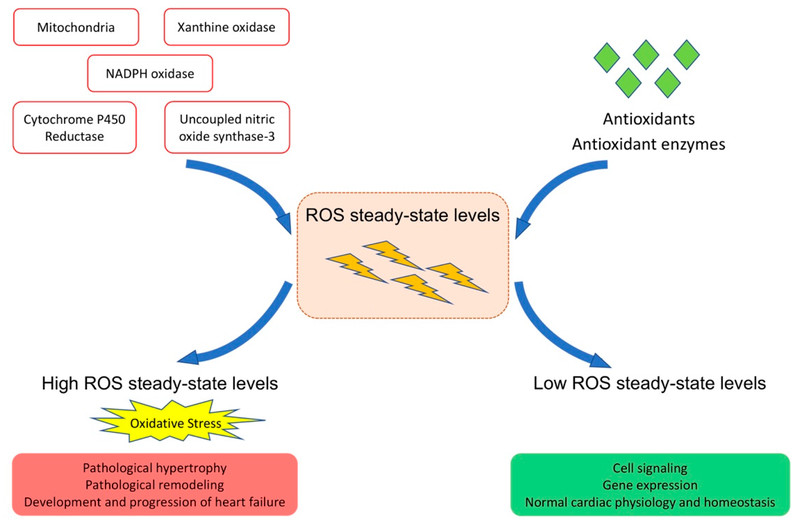Oxidative Stress-inducible Lentiviral Vector Service
Creative Biolabs is a global company which focuses on viral vector design and construction services. With our extensive experience and advanced platform, we can provide a series of services on oxidative stress-inducible lentiviral vectors basing on a wide variety of state-of-art technologies. We are dedicated to assisting our clients with the most satisfactory data to meet any requirement of your projects.
Oxidative Stress Introduction
Oxidative stress is an imbalance between reactive oxygen species (ROS) and the ability of detoxifying reaction intermediates or repairing damages in cells. In general, oxidative stress can affect the normal redox conditions and trigger the production of several compounds, such as free radicals, to destroy the function of different kinds of cells. Pilot studies have shown that oxidation stress plays a critical role in mediating a variety of diseases, including many cardiovascular diseases (CVDs). Meanwhile, many researchers have also revealed that the process of eliminating oxidation by developing specific antioxidant defenses will provide an attractive strategy for disease therapy. For instance, a number of genes, such as heme oxygenase-1 (HO-1), have been identified to be critical to gene therapy in treating atherosclerosis. Furthermore, more and more scientists have focused on designing gene therapy vectors basing on oxidative stress, and the antioxidant response element (ARE) has been generated into lentiviral vectors to improve vector efficacy in human primary endothelial cells. Additionally, a number of lentiviral vectors expressing various therapeutic genes have been developed by the induction of oxidative stress.
 Figure 1. Role of ROS in cardiac physiology and pathophysiology.1
Figure 1. Role of ROS in cardiac physiology and pathophysiology.1
Oxidative Stress-Inducible Lentiviral Vectors: A Breakthrough in Endogenous Precision Expression
Oxidative stress-inducible lentiviral vectors (OS-LVs) achieve a paradigm shift by utilizing pathologically elevated oxidative stress levels as a "natural switch" for gene expression.
- Specificity: Gene expression is activated only when cells are under the desired pathological oxidative stress state, thereby restricting expression to damaged cell populations.
- Integration Advantages: The inherent advantages of lentiviral vectors—high transduction efficiency, the ability to infect non-dividing cells (such as neurons), and stable integration into the host genome—ensure the long-term reliability required for both basic research and gene therapy applications.
Construction of Oxidative Stress-Inducible Lentiviral Vector
Molecular Components of Inducible Systems
The construction of high-performance inducible lentiviral vectors requires the careful assembly of multiple molecular components to achieve the desired regulatory properties. For Tet-inducible systems, these components typically include: (1) a regulatory plasmid encoding a reverse tetracycline-controlled transcriptional activator (rtTA) or tTA protein; (2) a response plasmid containing the gene of interest under the control of a minimal promoter fused to the tet operator (tetO) sequence; and (3) auxiliary elements that enhance system performance, such as transcriptional silencers or chromatin insulators.
Vector Packaging and Validation
Lentiviral vector packaging typically utilizes a three- or four-plasmid system to produce replication-incompetent viral particles in producer cells (typically HEK293T cells).
Stringent quality control and validation are critical steps in the production of oxidative stress-inducible lentiviral vectors. Standard validation procedures include:
- Titer determination using quantitative PCR (to measure vector genomes per milliliter) or functional assays (to measure transducing units per milliliter);
- Evaluation of induction kinetics by measuring the time- and dose-dependency of transgene expression in response to oxidative stressors (e.g., hydrogen peroxide, menadione, tert-butyl hydroperoxide);
- Specificity assessment by comparing induction under oxidative conditions with other stress conditions;
- Functional testing in biologically relevant assays to confirm that the expressed transgene produces the expected physiological effect.
Core Services at Creative Biolabs
Oxidative stress-inducible lentiviral vectors have shown promising results in gene therapy for various types of diseases. ARE-regulated genes have been cloned into the luciferase-reporter vector with an SV40 promoter to generate the oxidative stress-inducible lentiviral vectors. Creative Biolabs now provides a panel of inducible vector systems to design, construct and optimize lentiviral vectors. Of note, oxidative stress has been considered as one of the most popular inducible vectors for developing a range of novel lentiviral vectors in gene therapy. Up to now, we have designed and tested many oxidative stress-inducible lentiviral vectors for our worldwide customers.
- Custom Vector Design & Construction
- Lentiviral Packaging & Concentration
- Vector Validation
- Downstream Services
Our Services and Project Implementation Process
Our project process is designed to ensure transparency and collaborative execution, ensuring the final product meets rigorous scientific standards.
- Project Consulting and Design: Detailed discussion of the target cell line, desired induction level, and gene of interest (GOI). Selection of the optimal OSRE promoter sequence.
- Vector Construction: Synthesis of the OSRE and GOI, cloning into the SIN lentiviral backbone, and comprehensive sequencing to confirm vector integrity.
- Petite Production: Initial production and quality control (titer and sterility) of the lentivirus.
- Final Quality Control and Delivery: Final report including sequencing data, titer, sterility, endotoxin levels, and functional inducibility data.
Applications of Oxidative Stress-Inducible Lentiviral Vector Service
The precision of OSI-LV technology opens key avenues for biomedical research and treatment:
- Disease modeling: Creation of syngeneic cell lines or animal models in which the expression of pathogenic genes (e.g., mutant SOD1 in ALS) is specifically activated in response to the oxidative stress characteristic of disease states. This generates high-quality data on gene regulatory networks under physiological stress conditions.
- Targeted gene therapy: Delivery of therapeutic genes, such as anti-apoptotic factors (Bcl-2) or antioxidant enzymes (catalase, GPX), that are expressed only in pathologically stressed tissues (e.g., ischemic heart tissue or neurodegenerative plaques) significantly reduces systemic side effects.
- Drug screening: Development of reporter systems (e.g., luciferase driven by OSREs) to screen for compounds that enhance or inhibit oxidative stress responses, providing a high-throughput platform for new drug discovery.
- Mechanistic studies: Use vectors expressing shRNAs targeting key regulators (Nrf2 or Keap1) to dissect signaling cascades under redox perturbations.
Why Choose Creative Biolabs for Oxidative Stress-Inducible Lentiviral Vectors?
Professional Promoter Library
We meticulously maintain a collection of validated ROS-responsive promoters with published induction data in a variety of cell types (neurons, cardiomyocytes, and cancer cells). Our team optimizes these promoters to minimize basal expression (less than 5% of induction levels) and maximize induction levels (4-8-fold).
PhD-Level Research Team
All projects are led by scientists with over five years of experience in oxidative stress research and viral vector engineering. We not only construct vectors but also help you design experiments to answer your research questions.
High Titer and Purity
Our optimized packaging solution consistently delivers titers of 10⁸–10⁹ TU/mL, 10-fold higher than the industry average (10⁷–10⁸ TU/mL). Our purification process ensures endotoxin levels below 0.1 EU/mL, which is critical for in vivo applications.
Strict Quality Control
Each vector undergoes over five quality control tests (titer, induction efficiency, sterility, endotoxins, sequencing) to ensure reproducibility. We provide raw data (e.g., qPCR curves, Western blots) in quality control reports so you can trust your results.
Customer Review

"Creative Biolabs' OSI-LV was instrumental in our research on ischemia-reperfusion injury. This vector demonstrated an on/off fold induction ratio exceeding 15-fold in our primary cardiomyocytes following hypoxic stress, a level of control not achieved with the Tet-On system. Their meticulous quality control data documentation expedites our GEO application for gene expression analysis under stress conditions."
— Dr. E. Schmidt, MD, PhD
Frequently Asked Questions
Q: What is the typical induction rate achieved with your oxidative stress-inducible lentiviral vectors?
A: The induction rate depends on the specific response element used, the target cell type, and the nature of the oxidative stimulus. In optimized systems, we typically achieve 20-fold to 100-fold induction rates, comparing maximally induced expression to uninduced baseline expression.
Q: How rapidly is gene expression activated after oxidative stress induction? How long does it last?
A: The kinetics of induction depend on the specific response element and cellular context. With most oxidative stress-responsive vectors, transgene expression is detectable within 2-4 hours after exposure to the oxidative stimulus, with peak expression typically occurring between 12-24 hours.
Q: What purification method do you use for research-grade vectors?
A: The purification method is tailored to the downstream application. Sucrose gradient ultracentrifugation is typically used. This method provides high-titer, well-purified vector suitable for most in vitro and standard in vivo animal models.
Q: Can I use your OSI-LV system to simultaneously express two different genes, both under oxidative stress control?
A: Yes, we offer two main co-expression methods:
- IRES or 2A peptide systems: We can clone a bicistronic cassette into OSI-LV. This requires inserting a gene of interest (GOI) first, followed by an internal ribosome entry site (IRES) or a self-cleaving 2A peptide sequence, and finally a second GOI (or reporter gene). These two genes are transcribed into a single mRNA under the control of a single OSRE promoter and subsequently translated into two independent proteins.
- Dual-promoter vectors: To achieve independent expression levels, we can construct dual-promoter lentiviral vectors, placing the two GOIs under the control of two separate but identical OSRE elements.
Connect with Us Anytime!
Creative Biolabs is recognized as the world leader for providing the most diverse portfolio of viral vector-associated discovery solutions for worldwide customers. We are proud to partner with our clients on the journey of bringing novel delivery systems to the market. If you are interested in our services, please feel free to contact us for closer communication to learn how we can be involved in your project. Separate services or integrated end-to-end solutions are all welcomed.
Reference
- De Geest B, Mishra M. Role of oxidative stress in heart failure: insights from gene transfer studies. Biomedicines, 2021, 9(11): 1645. https://doi.org/10.3390/biomedicines9111645 (Distributed under Open Access license CC BY 4.0, without modification.)
